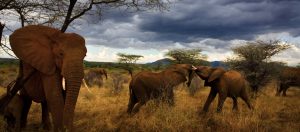
Our new Northern Kenya Elephant Tracking project is now live, following a successful initial deployment of the first set of tracking collars last week. Over the coming three years we will use 40 new collars to understand – and protect – the region’s elephant population, in line with the Kenya Wildlife Service Elephant Strategy. The project is only possible thanks to the support of the Nature Conservancy & the Northern Rangelands Trust.
Beyond providing a critical data flow into the security networks of the Kenya Wildlife Service and the Northern Rangelands Trust, the tracked elephants will help us identify critical areas for elephants in the region where protection can be increased, determine what drives the expansion or retraction of their range, and identify the critical corridors that link the mosaic of protected areas in this region.
In addition, these collars will give us a comprehensive look at how the elephant distribution in Samburu changes over the course of the year, characterizing the seasonal fluctuations that are driven by dynamics in water, food and security.
With pressures from large scale infrastructure development projects that will bring a new railway, highway and oil pipeline through the ecosystem, this information is of paramount importance to the landscape planners and the conservation of this vast and wild ecosystem.
The Challenge of Choosing Elephants
To assess the current distribution of elephants, we undertook a massive reconnaissance flight across the northern Frontier of Kenya earlier this week, during which we searched along any dry riverbeds which looked to retain some water during these rainless months. It was wonderful to find elephants out in the far edges of the ecosystem, areas only a few years ago elephants never would have used due to a lack of security and competition with people.
While the rains over the past year have been poor in Samburu, they were much better on the far eastern and northern boundary of Northern Kenya’s elephant range. This has drawn elephants out into some of the most remote areas in the ecosystem, areas elephants have only begun to use in the past few years as they begin to expand their range through the Northern Rangelands Trust Ecosystem.
We decided to take advantage of the fact that elephants are in these far outlying areas launch the Elephant Tracking in Northern Kenya project by deploying the first four satellite GPS collars.
Collaring
After our flight identified areas of with clusters of elephants, David and I loaded up the Lewa helicopter (from which the Kenya Wildlife Service (KWS) would dart) and a Northern Rangelands Trust Super Cub fixed wing plane (which would spot during the operations) with equipment for four elephants and headed out to the far Eastern boundary of the ecosystem.
KWS Vet Dr Rono started by darting a 20 year old bull elephant near a hotspring in the middle of Biliquo. The first dart did not dispense the drug which would put him to sleep, so we had to make a second pass in the helicopter to get an effective dart. As the male began to slow down, he started to maneuver himself in thick bush (a good defense strategy).
Mike Watson, CEO of Lewa Wildlife Conservancy, did a superb job of gently pushing him with the helicopter out of the thickets into more open country, where he finally went down on his stomach (a position that is not good for the elephant’s health). We started to put the collar on, but then decided to push him onto his side so his breathing would not be compromised. It wasn’t easy, but the four of us managed to push him over, secured the collar, and revive the bull, now named Madurba after the location where he was collared. Within a minute of getting the anecdote, he popped up, tested the collar (smelling around where we had worked) and ambled off into the bush with an irritated shake of his head!
Sad signs
At one point we landed the chopper on top of a small hill to liaise with our ground team, who showed us the tracks of a family group of five elephants. Sadly, it was clear from the foot prints that the family lacked an older matriarch and was comprised of all young individuals-the tell tale signs of an orphan group that is likely a repercussion of poaching epidemic that hit the region. We hoped to find this group so we could collar and monitor them, but they turned out to be incredibly good at camouflage and helicopter aversion!
Over the course of the day we managed to fit tracking collars onto three more elephants in this wild, remote country. Long may these animals speak to us of how they use this landscape, and teach us how best to protect it for them long into the future.

